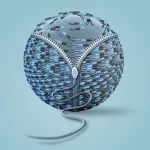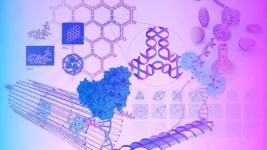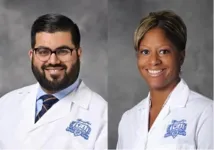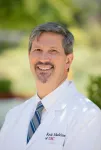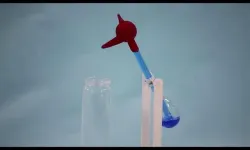(Press-News.org) With the help of the ESRF, researchers from Karolinska Institutet (Sweden) have discovered the reproductive mechanism that permanently blocks polyspermy — a pathologic condition that arises when more than one sperm fuses with the egg, and which is lethal for embryo development. They also revealed the atomic architecture of the egg coat, which explains a set of genetic mutations causing infertility and it could make an impact in the development of non-hormonal contraception. The results are out in the journal Cell.
Infertility affects around 15% of couples worldwide, according to the World Health Organization (WHO). Some cases of infertility are associated with mutations in the genes that are responsible for egg coat formation. The egg coat, also known as zona pellucida (ZP), is an extracellular matrix essential for egg growth, fertilization and protection of the embryo until it implants into the uterus. The ZP consists of several proteins, which polymerize into long filaments that form a “mesh” around the egg. Mutations in ZP proteins may cause defects or lack of this mesh.
It is currently unclear how many of them carry pathogenic mutations in ZP genes, because not all infertile women have their genome sequenced. However, several different types of such mutations have been reported to date.
“We need to understand the processes that take place during fertilization at the molecular level”, says Luca Jovine, professor at Karolinska Institutet in Sweden and leader of the study. Together with researchers from Osaka, Tokyo and Pittsburgh universities, as well the ESRF, they have found how ZP filament rearrangement prevents the fertilization of an egg by more than one sperm.
Until today, scientists knew that, after a sperm fuses with the egg, the egg releases an enzyme that specifically cleaves a major ZP protein called ZP2. Also, it was long known that the egg coat becomes ‘harder’ after fertilization, and sperm can’t penetrate it anymore. However, the connection between these processes and the basis of the block to polyspermy remained unclear. “We knew that these events were associated, but a molecular mechanism linking the different pieces of the puzzle was missing”, explains Jovine.
The team aimed to investigate the structure of ZP2 before and after the cleavage triggered by egg-sperm fusion, and how ZP2 cleavage may change the overall structure of the ZP mesh. To do so, they determined different ZP2 and egg coat filament structures using X-ray crystallography at the ESRF, Diamond Light Source and BESSY II, as well as cryo-electron microscopy at SciLifeLab in Stockholm. The team has been a regular user of the X-ray crystallography beamlines at the ESRF for more than 15 years. Daniele de Sanctis, scientist in charge of beamline ID29 at the ESRF and co-author of the study explains: "Seeing the atomic details of such a fundamental process of life is simply amazing. Throughout the years, we have been applying the state of the art of what the ESRF beamlines could offer to solve the structure of the molecular bricks that compose ZP”.
Jovine and colleagues discovered that cleavage of the part of ZP2 that protrudes from the egg coat filament allows it to form new interactions with other ZP2 molecules. These interactions create an extensive network of cross-links that bring filaments closer to each other. By stiffening the egg coat and tightening its mesh, this prevents additional spermatozoa from penetrating the ZP. “It is like a zip that is being done up”, says Jovine.
Mechanical system
The system does not block polyspermy by abolishing sperm binding to the ZP (as it was previously believed), but rather by hindering sperm penetration of the egg coat. “The mechanical system that we discovered is very logical from an evolutionary point of view, because it permanently blocks sperm in a way that does not depend on how this attaches to the egg coat, which may vary in different species”, explains Jovine.
Whilst these findings are at a fundamental level, they have important implications for future reproductive medicine: “For the first time we have a molecular view of how the egg coat changes its architecture after fertilization and how this affects its function. This knowledge allows us to interpret the growing number of human ZP gene mutations linked with female infertility”, explains Jovine. “At the same time, since the egg coat is required for fertility in vivo, detailed information on its structure could have diagnostic applications and may, in principle, be exploited for developing non-hormonal contraceptives”, he concludes.
The ESRF structural biology beamlines have played a very important role in this pursuit. Back in 2017, they provided the first example of how egg coat and sperm recognize each other at the beginning of fertilization and in 2010 they solved the 3D structure of ZP3, another major egg coat subunit that is also thought to act as a receptor for sperm. “We are now already planning for new experiments that the new Extremely Brilliant Source at the ESRF has made possible”, concludes De Sanctis.
Reference:
Nishio S. et. , Cell 187:1440-1459 (2024) https://doi.org/10.1016/j.cell.2024.02.013
END
How does the body avoid that multiple sperm fertilize an egg?
2024-03-14
ELSE PRESS RELEASES FROM THIS DATE:
ASU Biodesign institute scientist Hao Yan receives prestigious Humboldt Research Award
2024-03-14
Hao Yan, director of the Biodesign Center for Molecular Design and Biomimetics at Arizona State University and the Milton D. Glick Distinguished Professor within ASU’s School of Molecular Sciences, has been honored with the Humboldt Research Award by the Alexander von Humboldt-Stiftung Foundation.
This prestigious $65,000 award acknowledges Yan's extensive achievements in research and education.
"The institute is thrilled that the Humboldt Society is honoring Hao for his pathbreaking research and outstanding contributions as a mentor to young scientists,” says Joshua ...
Henry Ford Health cardiologists lead national study on novel bleeding monitoring system
2024-03-14
DETROIT (March 14, 2024) – Interventional cardiologists at Henry Ford Hospital led a national multi-center clinical study, dubbed the “SAFE-MCS” study, that evaluated the safety of complex high-risk percutaneous coronary intervention (PCI) using mechanical circulatory support (MCS) and surveillance with the Early Bird® Bleed Monitoring System (EBBMS).
PCI is a non-surgical procedure used to treat the blockages in a coronary artery that opens narrowed or blocked sections of the artery, restoring blood flow to the heart.
“This study is the first ...
Ecology: Increasing sea temperatures associated with higher bull shark abundance
2024-03-14
Increasing sea surface temperatures over the past 20 years in Mobile Bay — an estuary in the US state of Alabama — have coincided with five-fold increases in the abundance of juvenile bull sharks (Carcharhinus leucas), according to a study published in Scientific Reports.
Bull sharks are found globally in warm, shallow coastal waters in both fresh and saltwater environments. They help balance and maintain the health of coastal ecosystems by regulating prey populations. Along with great white shark (Carcharodon carcharias) and tiger shark (Galeocerdo cuvier), they are among the shark species that are most like to negatively interact with humans.
Lindsay ...
New study examines if ‘inoperable’ pancreatic tumors can be safely removed
2024-03-14
LOS ANGELES — A clinical trial from Keck Medicine of USC aims to provide a surgical solution for patients with a form of advanced pancreatic cancer previously considered inoperable.
The study will investigate if chemotherapy followed by a novel type of surgery to remove the cancer is a safe and effective option for patients with locally advanced pancreatic cancer, meaning that the cancer has not spread to other organs, but has grown into or close to nearby blood vessels that surround the pancreas.
“Usually, these types of tumors cannot be ...
Terminator-style robots more likely to be blamed for civilian deaths
2024-03-14
Advanced killer robots are more likely to blamed for civilian deaths than military machines, new research has revealed.
The University of Essex study shows that high-tech bots will be held more responsible for fatalities in identical incidents.
Led by the Department of Psychology’s Dr Rael Dawtry it highlights the impact of autonomy and agency.
And showed people perceive robots to be more culpable if described in a more advanced way.
It is hoped the study – published in The Journal of Experimental Social Psychology ...
An electricity generator inspired by the drinking bird toy powers electronics with evaporated water
2024-03-14
Inspired by the classic drinking bird toy, scientists in Hong Kong and Guangzhou, China have developed an engine that efficiently converts energy from water evaporation into electricity to power small electronics. The device produces energy outputs exceeding 100 volts—much higher than other techniques that generate electricity from water—and can operate for several days using only 100 milliliters of water as fuel, according to a study published March 14 in the journal Device.
“The drinking bird triboelectric hydrovoltaic generator offers a unique means to power small electronics in ambient ...
Cell focus issue explores sex and gender in science
2024-03-14
Cell, the flagship biology journal of Cell Press, presents a landmark issue on sex and gender in science. It includes a collection of articles on topics related to strategies for promoting gender equality in academia, enhancing rigor in the study of sex-related variables, and supporting transgender researchers. The special content, scheduled to appear online on March 14, 2024, also discusses the past, present, and future of research on sex and gender.
To mark the occasion, Cell Press’s parent company, Elsevier, is announcing updated guidelines on reporting ...
Transgender scientists speak up about the challenges they face in academia and share how to support them
2024-03-14
A group of 24 transgender (and/or family members of transgender) scientists describe what it’s like to be a transgender person in STEMM. In a commentary publishing on March 14 in the journal Cell, they discuss the historical origins of trans marginalization, explain how this affects trans people’s careers in science and medicine, and lay out actions that cisgender individuals and institutions can take to support trans people in STEMM.
This first-of-its-kind commentary appears in a sex and gender focus issue of Cell, covering topics such as gender equity, the history ...
Sleep-wake rhythm: Fish change our understanding of sleep regulation
2024-03-14
Contrary to common belief, not all vertebrates regulate their sleep-wake rhythm in the same way. University of Basel researchers have discovered that some fish – unlike humans – do not need orexin to stay awake. This molecule was thought to be necessary for normal wake and sleep rhythms in vertebrates. Humans without orexin suffer from narcolepsy.
Until recently, it was assumed that vertebrates share similar mechanisms controlling sleep behavior. That's why researchers have been using fish in the past 20 years as a model organism to study sleep ...
New discovery reveals how the egg controls sperm entry
2024-03-14
After the egg has been fertilized by a sperm, the surrounding egg coat tightens, mechanically preventing the entry of additional sperm and the ensuing death of the embryo. This is according to a new study led by researchers at Karolinska Institutet and published in the journal Cell. The work also explains how mutations in egg coat proteins can cause female infertility and may eventually lead to new contraceptive methods.
Fertilization in mammals begins when a sperm attaches to the egg coat, a filamentous extracellular envelope that sperm must penetrate ...
